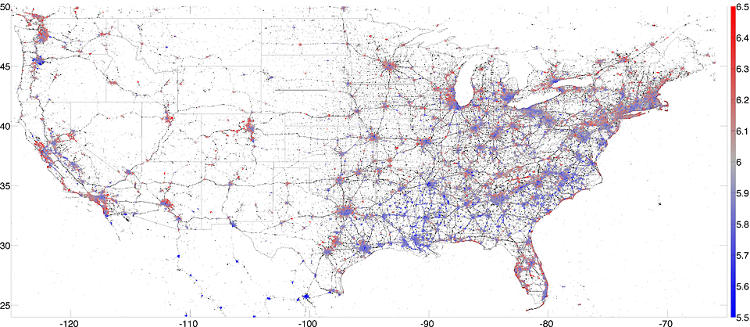This guest post has been written by Sanne van der Beek. An earlier Dutch version of this article was published at the blog of Stadsleven, a monthly talk show about city life in Amsterdam.
How do you measure something as subjective and diffuse as happiness? And: is it possible to determine what is the happiest place on the world? New technologies like Twitter and iPhone apps come the rescue. The Hedonometer for instance analyses the happiness levels from words in English tweets. In order to do so, the researchers have scored the 10,000 most used words from Google Books, articles in the New York Times, song lyrics and twitter messages on their happiness level. It won’t be a surprise that ‘laughter’ scores a lot higher than ‘killed’ or ‘bored’. Even words that are less closely linked to emotion have been ranked. ‘Rainbow’ takes home 8.06 out of 9; alcohol doesn’t get more than 5.2.
Hedonometer’s analysis of the US. Hawaii is the happiest state, Lousiana the least happy one.
Every day, Hedonomoter analyses the presence of these words in 50 million tweets from around the globe. Together, these tweets form a daily ‘happiness average‘. In this way, you can measure the happiest day of the year, or the average level of happiness per state.
Mappiness: the largest global happiness study through iPhone
Mappiness is a free iPhone app conducting the largest research on the influence of environment and community on human well-being ever. Since 2010, the app has been downloaded by almost 60,000 people. How does Mappiness work? At irregular intervals, the app asks you about your state of being. The app also wants to know exactly where you are, and in whose company. The choice amongst forty options takes about twenty seconds, and must be made within one hour to be classified in the results. Initial results from the London School of Economics on the basis of over 3 million data points demonstrated that people are somewhat happier in nature, forests or at the coast than in urban environments.
Would you like to read more?
Sanne’s entire dossier (in Dutch) ahead of Stadsleven’s talk show on The Happy City can be found here.
I contributed an article on the lessons from Bhutan for the Happy City (English translation on my blog). After the event, I wrote a post about the conclusions of the panel: compactness, connections, trust and design are the winning factors for happy cities!

